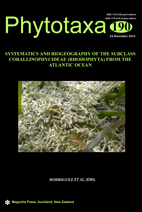Abstract
The Late Miocene Malbusca outcrop is located in the southeastern coast of Santa Maria Island (Azores, NE Atlantic), interspersed in volcanic formations. At ~20 meters above present sea level, a prominent discontinuous layer of rhodoliths seizes with an extension of ~250 meters. This paper presents the first taxonomic record of fossil rhodolith forming coralline algae for the Miocene of the Azores. The preserved taxonomic features used were the following: (1) arrangement of basal filaments, (2) epithallial cells (when observable), (3) presence of cell fusions, (4) conceptacle type, (5) number of cells layers which conceptacle chamber floors are situated below the surrounding thallus surface and (6) for the sporangial pores, the orientation of the filaments around the conceptacle pores. Based on these characters, six taxa were identified encompassing three Corallinaceae (Lithophyllum prototypum, Lithophyllum sp., Spongites sp. and Hydrolithon sp.) and one Hapalidaceae (Phymatolithon calcareum and cf. Phymatolithon sp.). An unidentified coaxial thallus was also present, the coaxial construction ascribing the specimens to the genus Mesophyllum or Neogoniolithon. Taxonomic accounts for the identified taxa are described, illustrated and an identification key is provided. The report of L. prototypum represents the first Miocene record and the preservation of the specimens is very good. Miocene coralline algae seem very consistent among deposits but some species are relevant for particular areas, like in the Azores.

